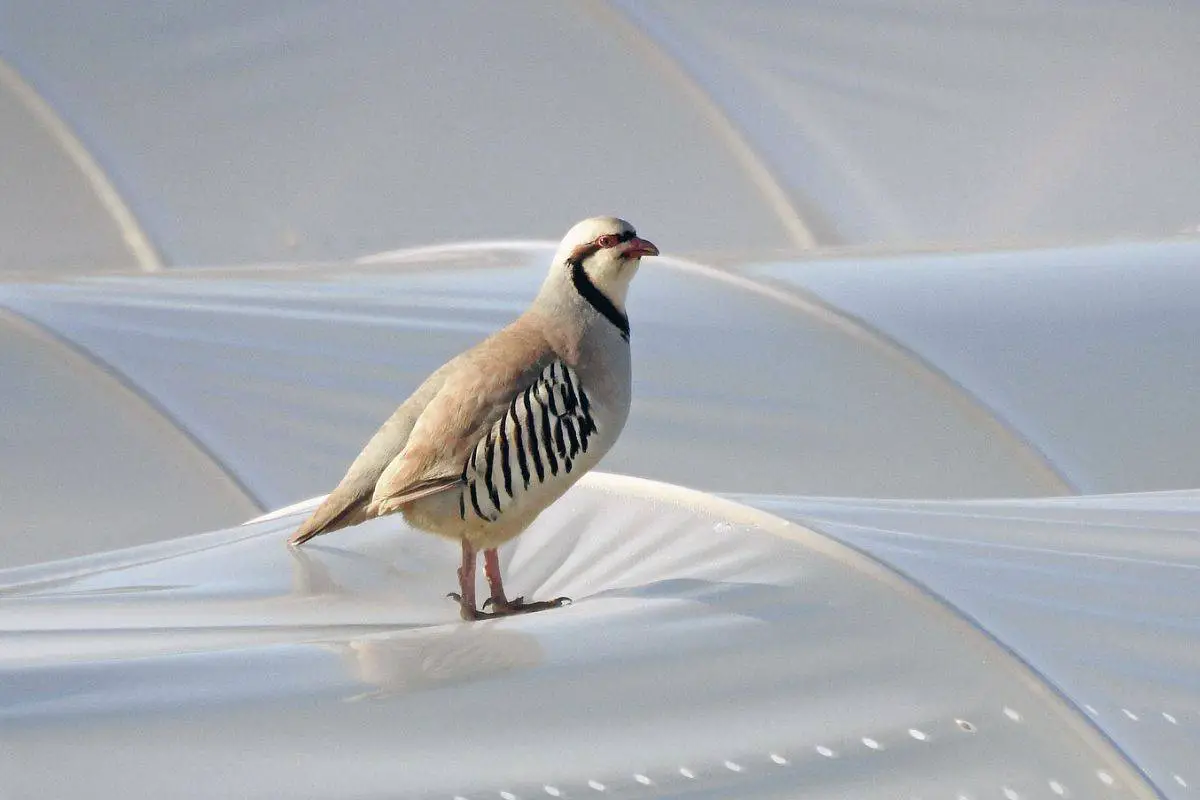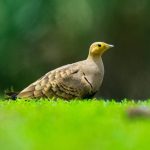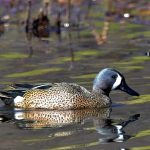Common Name: Chukar Partridge
Scientific Name: Alectoris chukar| Size | Diet | Range in Hawaii | Status in Hawaii |
|---|---|---|---|
| 14 in. - 17 in. | seeds, fruits, insects, and small animals | the Big islands, Maui, and Molokai | Least Concern |
The Chukar Partridge (Alectoris chukar) is a medium-sized game bird native to Eurasia and the Middle East. Known for its distinctive appearance and strong, agile flight, the Chukar Partridge is a popular game bird for hunting and is also kept in captivity for its meat and eggs.
While the Chukar Partridge is not native to Hawaii, it has been introduced to the islands on multiple occasions for hunting purposes. The bird is known to inhabit higher elevations and rocky terrain, and it has established populations in certain areas of Hawaii, particularly on the Big Island.
Despite its non-native status, the Chukar Partridge has become a popular game bird in Hawaii and is enjoyed by hunters and nature enthusiasts alike.
Chukar Partridge
Appearance
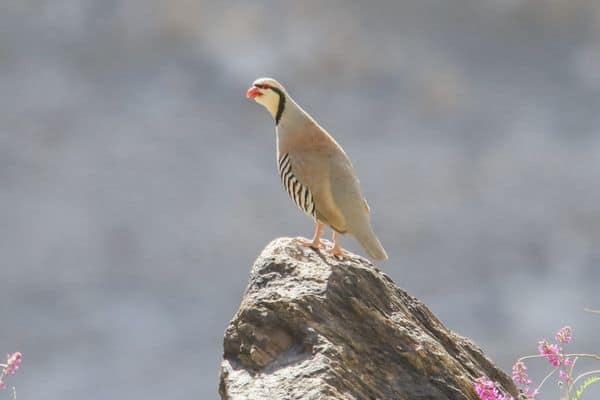
The Chukar Partridge is a medium-sized bird, measuring around 14-17 inches (36-43 cm) in length and weighing between 1-2 pounds (0.5-1 kg). It has a distinctive appearance, with a gray-brown body, black and white stripes on its flanks, and a black band across its forehead.
The bird also has a bright red beak and legs, and its eyes are surrounded by a red ring. Male and female Chukar Partridges have similar appearances, but males are slightly larger and have more pronounced black and white stripes on their flanks. Juvenile birds have a more muted appearance, with lighter brown plumage and less distinct markings.
Diet
The Chukar Partridge is an omnivorous bird that feeds on a variety of foods, including seeds, fruits, insects, and small animals. Its diet varies depending on the season and availability of food, but it generally consists of a mix of plant and animal matter.
In the summer months, Chukar Partridges feed on a variety of plant foods, such as seeds, berries, and grasses. In the winter months, when food is scarcer, they rely more heavily on insects, such as grasshoppers and beetles, as well as small mammals and reptiles.
Behavior
The Chukar Partridge is a social bird that typically lives in flocks or coveys, particularly during the winter months. It is known for its strong, agile flight and can often be seen flying through rocky terrain or steep slopes.
During the breeding season, male Chukar Partridges will establish territories and engage in courtship displays, which include calling, strutting, and puffing up their feathers. Females will lay a clutch of 8-20 eggs, which they will incubate for around 23-28 days.
Chukar Partridges are known for their adaptability and can thrive in a range of habitats, from arid desert regions to mountainous terrain. They are also highly vocal birds and use a range of calls and vocalizations to communicate with each other and establish territories.
Nesting
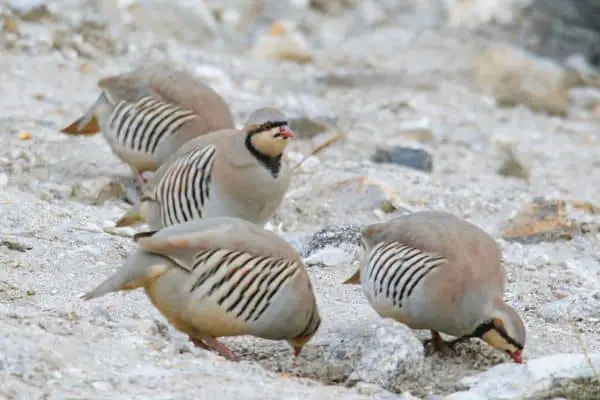
The Chukar Partridge typically nests on the ground, often in rocky terrain or steep slopes. The female will lay a clutch of 8-20 eggs, which she will incubate for around 23-28 days.
Once the eggs hatch, the young chicks are precocial, which means they are able to move around and feed themselves shortly after hatching. The female will continue to care for and protect the chicks for several weeks, until they are able to fend for themselves.
Habitat
The Chukar Partridge is a bird that is native to rocky, mountainous regions of Eurasia and the Middle East, but it has also been introduced to other parts of the world, including North America and Hawaii.
Chukar Partridges are adapted to living in arid and semi-arid environments, and they can be found in a variety of habitats, including rocky slopes, scrubland, grassland, and desert regions. They are able to survive in areas with limited water and vegetation, and they are often found in areas with steep terrain and rocky outcroppings.
Range
The Chukar Partridge is native to a wide range of rocky, mountainous regions in Eurasia and the Middle East, including countries such as Pakistan, India, Afghanistan, Iran, and Turkey. In addition to its native range, the Chukar Partridge has also been introduced to other parts of the world, including North America, Hawaii, New Zealand, and Australia.
In Hawaii, the Chukar Partridge has been introduced to the islands of Hawaii, Maui, and Molokai, where it is often hunted for sport.
Conservation Status

The Chukar Partridge is not considered to be globally threatened or endangered, and it is classified as a species of “Least Concern” by the International Union for Conservation of Nature (IUCN). However, the bird’s populations in certain areas may be impacted by hunting, habitat loss, and other human activities.
Although the Chukar Partridge is not considered to be a threatened or endangered species in Hawaii, its presence on the islands is classified as an introduced species and may have ecological impacts on native species and habitats. Hunters often pursue the bird for sport, and its populations may be managed through hunting regulations and other methods.
Interesting Facts
1. Known for their adaptability
Chukar Partridges are known for their adaptability and can thrive in a range of habitats, from arid desert regions to mountainous terrain.
2. A popular game bird
The Chukar Partridge is a popular game bird for hunting and is also kept in captivity for its meat and eggs.
3. Known for their strong, agile flight
Chukar Partridges are known for their strong, agile flight and can often be seen flying through rocky terrain or steep slopes.
4. A monogamous bird
They are monogamous birds, and pairs will often stay together for multiple breeding seasons.
5. Ability to survive in harsh environment
Their hardiness and ability to survive in harsh environments have made Chukar Partridges a model organism for studying the physiological adaptations of birds to extreme environments.
Frequently Asked Questions
1. Where is the Chukar Partridge native to?
The Chukar Partridge is native to rocky, mountainous regions of Eurasia and the Middle East.
2. What is the lifespan of a Chukar Partridge?
The lifespan of a Chukar Partridge in the wild is typically around 3-4 years, although they can live up to 10 years in captivity.
3. What is the Chukar Partridge’s vocalization like?
They communicate with each other and establish territories using a range of calls and vocalizations, and their calls are often described as a loud, repetitive “chuk-chuk-chuk” sound.
4. What are some interesting behaviors of the Chukar Partridge?
Chukar Partridges engage in a range of interesting behaviors, including dust-bathing, sunbathing, and communal roosting.
